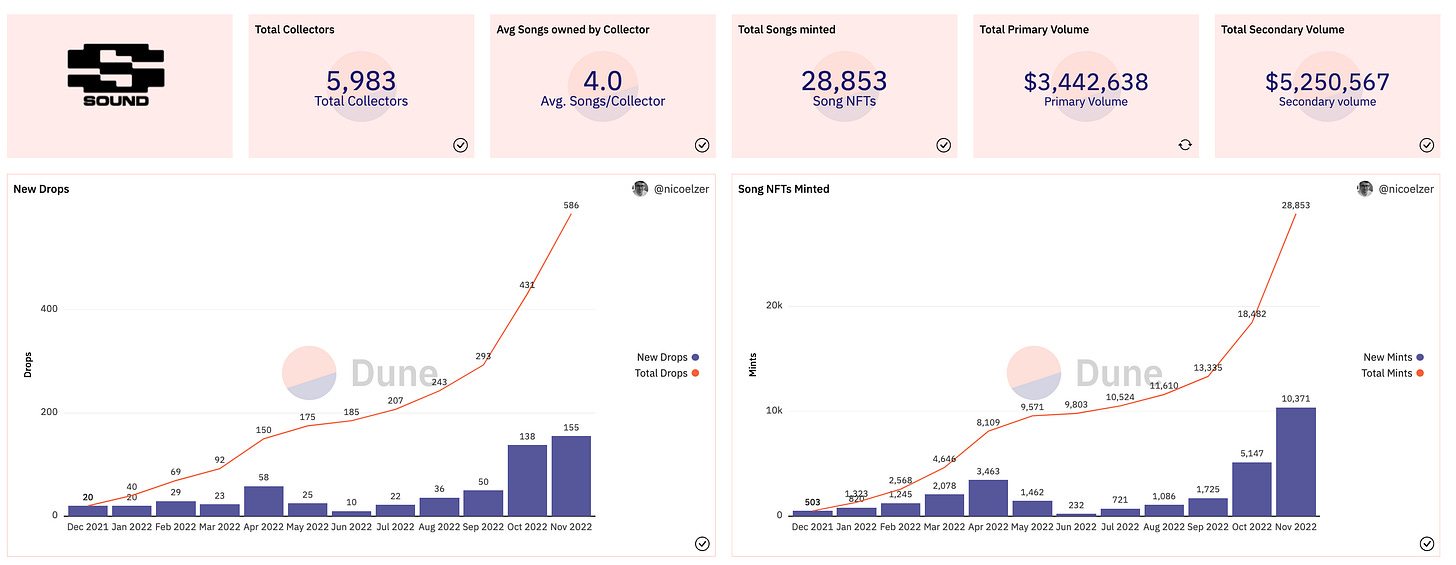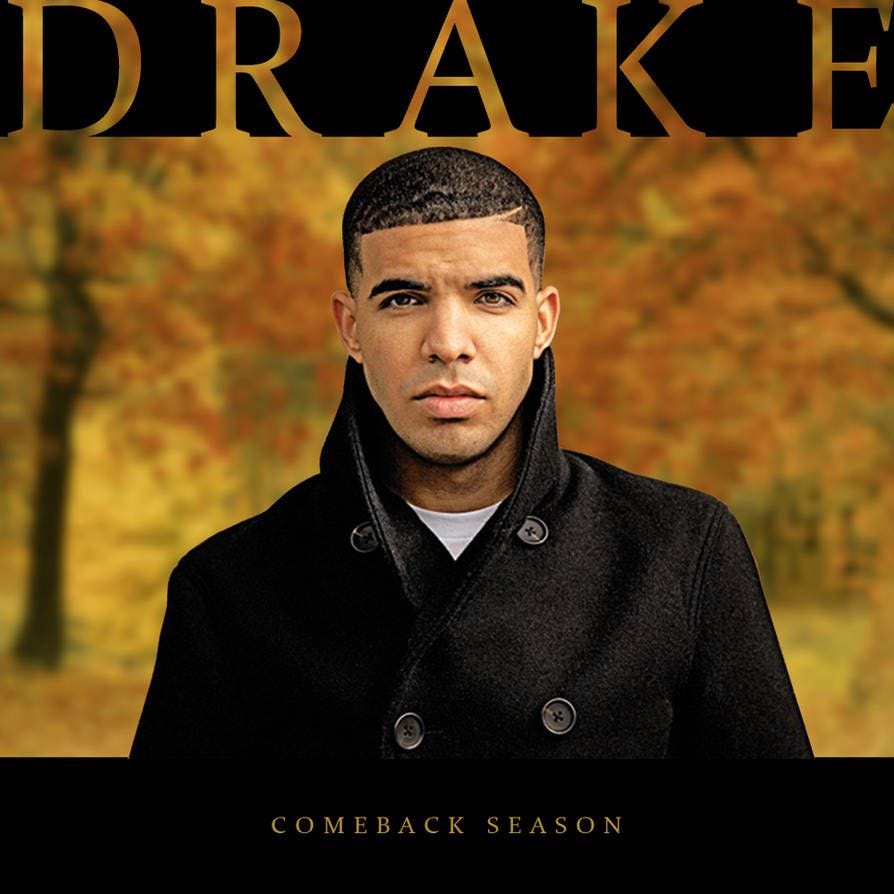Sound On
Can Sound.xyz build the next SoundCloud?
Hi Friends 👋🏽,
A warm welcome to the 75 new subscribers who joined us last week! If you haven’t subscribed, join 1,238 crypto-curious members by subscribing here:
This week I’m heading down to Miami to speak at Metaverse Miami, a new conference that is taking a Web3 native approach to programming, ticketing, and networking. I had an opportunity to sit down with their co-founder, Kenobi, last week for the pod. Be sure to check it out and come say hi if you’ll be in Miami!
For this week’s One Big Idea we are diving into the vibrant community developing on Sound.xyz, a music NFT platform with ambitions of becoming the next SoundCloud. In a time where most projects are cratering, Sound has found a way to add more users, artists, mints, and sales. So what’s going on?
Let’s dive in.
Last November, Suzy Ryoo (Co-Founder of Venice Music) and I descended on a cold New York for NFT NYC. Our objective was to leave the conference with a clear north star for our web3 strategy, which we had contemplated for nine months. As COVID sanctions began to unwind, NFT NYC represented the first opportunity to see many of our internet colleagues in person for the first time. While you can spend your entire day on Clubhouse and Twitter Spaces, there is no substitute for face-to-face interactions.
That NFT NYC would prove to be foundational for many in the space. For us, it helped solidify relationships that turned into collaborations. Whether it was sitting in a bustling coffee shop turned DJ booth with Nait Jones to discuss Royal, grabbing Mediterranean food with Alex Siber of Catalog, splitting a cab with Aidan Cullen of The Heart Project, a tutorial on DAOs from Trevor McFedries of FWB, or a blind coffee date with Verite and Vanessa Magos. NFT NYC was a whirlwind of meaningful discussions with individuals who are now paving the way for web3’s future.
One meeting, in particular, has been replaying in my mind. Before meeting this individual, I spent the morning reviewing mock-ups of their soon-to-launch website. A two-tonal sound-wave stretched across the page, representing a song in the process of being played. Icons scattered the track as individuals commented on their favorite parts.
The UI was instantly recognizable. This was SoundCloud…with a twist.
Those commenters gained social abilities by minting the track and earning an exclusive “seat at the table.” These seats were minimal (usually between 25 and 100). My first thoughts were one of skepticism. “Who wants to pay to comment?” I wondered. Not only was its niche in terms of consumption it was objectively worse. Why come to a site to listen to a few songs when I had the world’s catalog in my pocket on Spotify?
Skeptical, I ventured downtown to meet with David Greenstein, Co-Founder of Sound.xyz to discuss. The value proposition for artists was clear. Earn in minutes what would take years on streaming. Finally, properly valuing music instead of commoditizing it. But what about collectors? Would they value this new format?
It’s been over a year since our sit down that cold fall day, and so far the answer is yes. As of November 27, 5,983 unique collectors had purchased over $8.7 million worth of Sound.xyz NFTs. Holders, volume, mints, and artists on the protocol have increased month over month at numbers not seen since the bull run of Spring 2022. How, when most projects struggle to maintain their floors and churning users, is Sound experiencing such growth in the middle of the bear?
Sound’s success can be explained by what I’m calling the three C’s: Community, Context, and Clout. Combined with a team who continually ships meaningful advancements to meet the needs of its users, Sound is building a lurking juggernaut.
Community
When I first looked at those mock-ups of Sound, I never anticipated the vibrant ecosystem of artists and collectors that would emerge. We are witnessing the evolution of the fan club. Instead of artists communicating unilaterally at a distance, we are seeing the formation of symbiotic group chats. It’s like we are all sitting around a campfire. The art is what initiated the meetup but what keeps people coming back is the sense of belonging felt with other members of the community.
One strong indicator of a community forming is the development of language. Inside jokes, shorthand, and memes all indicate a community’s stickiness. This past weekend alone, I: 1) found myself minting a joke song paying homage to an expected bot, 7026, and 2) being interrogated by FaceTime by a handful of artists and collectors to determine if I was behind “Carl,” an expected alt account by someone in the community. These examples may seem trivial, but they represent a connection beyond financial speculation.
Context
If you’re a 20-30 something millennial, you’re old enough to remember the glory days of the “blog boy era.” Pigeon & Planes, 2 Dope Boys, and DJBooth stood at the forefront of music culture. Traditional publications were washed. We rushed home after school to see what new artists were labeled “next up.” Music was linked to mixtape sites like Datpiff and the unlicensed streaming service SoundCloud.
To be a music lover during this time was to be a futuristic crate digger. Finding what was hot before your friends, then reveling in the artist’s success when they “made it.” It was through these sites that I first heard Drake’s Comeback Season in 10th grade. Loaded up on my iPod Touch, I sat in the back of history class listening to this kid who managed to get Trey Songz on his mixtape!
Music had context. Every artist had a story. Every discovery had meaning. To experience music was not just to listen but to be engrossed in it.
In the streaming era, we’ve lost context. Songs come at us faster than we can blink. Algorithmic playlists are filled with faceless musicians. Our “favorited songs” have become bloated from many years of aimless liking. Many of us, myself included, have resigned to let streaming do the hard work of discovery. We are opting to throw on a prepackaged selection of tracks that’s good enough for our needs.
It’s not that music lost its soul. It’s that distribution did.
With Sound, the context has come rushing back to the foreground. Each new music drop is celebrated as a moment to be captured in time. Leading up to the release, artists will host Twitter Spaces to share the experience with the community. These spaces culminate in a listening party on Sound. While listening to the track together, the community explores the release page. A canvas onto which artists share intimate details of the release.
On Sound, artists are not numbers in an ever-growing catalog. They are individuals to be celebrated. Their stories are to be recognized and cherished. This intentionality has led to collectors building real sentimental value with their collections. These NFTs are not speculative assets to be flipped at the ready. They are an ode to an artist’s journey and the collector’s relationship to it.
Clout
Sound elevating collectors is a crucial reason for its success. Social products are status-driven, and participants need ways to demonstrate their status. Sound recognized this through their emphasis on collector features. They are starting with the collector profile and trending page.
Collector pages are status symbols. One’s ranking sounds collected, and artists supported signal their place within the music NFT ecosystem. Sound has gamified the experience of collecting. With each collect, you experience the thrill of climbing the leaderboard in real-time. With each drop, you’re hit with the dread of losing your place.
As a collector, Sound appeals to several status qualifiers. Being early (to the first drops on sound and genesis artist releases), being consistent (showing up in top collectors each week), and being the most significant (good luck catching Cooper). Clout also comes from the demonstrable taste. Curating playlists of your collection helps to represent your interests to the world (follow me for the Sad Boi vibes).
Shipping
Product market fit is a bit of a misnomer. It implies the product will reach a final form, at which point it will perfectly match the needs of its intended user base. In reality, searching for product market fit is a never-ending journey.
Sound is acutely aware of this fact. So much so that “shipping” has become a meme within the Sound community. The team ships features, artists ship music, and collectors ship threads (or newsletters, in this case).
The team identifies a pain point with each shipment, responds with products, receives feedback, and iterates. In recent months the team has shipped:
Sound Protocol: democratizing the Sound smart contract for all artists to use on their sites while maintaining curation on sound. XYZ.
Presale: enabling artists to reward past collectors with early, discounted access to future releases.
Playlists: Enabling collectors to demonstrate their curatorial prowess within their collections and across all releases on the protocol.
Activity feed: Allowing users to customize what mints, sales, and playlists they see across Sound.
In such a nascent space as Music NFTs, shipping is necessary for products to evolve with their understanding of the market's needs. With each iteration, Sound hopes to acquire new users, engage its existing base, and retain them at a higher rate. No one thinks Music NFTs have reached their final form, and while thousands of unique holders are a great start, Sound will need to continue to ship to see the significant scale.
Conclusion
While initial signs are encouraging, mainstream adoption is not inevitable. Sound’s total volume (primary + secondary sales) would be good enough for a top 600 project on OpenSea. Its holder count is akin to a single 10,000 PFP project. Outside my echo chamber, most of my peers don’t “get” Music NFTs. A common refrain is, “I understand why this is good for artists, but how is this a better consumer experience”?
Sound’s trajectory depends on two things. First, its value proposition is compelling enough for users to rethink how they interact with and collect music. Second, it can successfully ship and acquire new users. I’m excited to see how both of these play out in 2023 as we see more and more artists experimenting with NFTs.
Sound is not trying to be the next Spotify. We already have a pretty damn good, lean-back listening experience, and it remains where I consume most of my music and podcasts. What Sound does better than Spotify is bringing presence back to music. Where emotional connection is forged as faceless streams become intentional mints. Communities are held together by their love of art, and collectors are acknowledged for their participation.
To overuse a common meme, we are still early. Maybe Sound and Music NFTs never reach breakout status. But I’m encouraged by the early signs and excited to see how it develops in the future.
Have a great week everyone. Hope to see some of you down in Miami. Be back on Wednesday with another episode of The One Big Idea Podcast.
austin









So far, it seems like Music NFTs are for the music nerds/superfans of music. I wonder what will be the catalyst to be able to bring the more casual fans to want to invest in Music NFTs